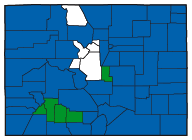
Pituophis catenifer

Field ID: This sturdy snake is yellowish or cream colored with a regular, dramatic pattern of dark blotches down the back. The scales are keeled. Size: 48–100 inches (121.9–254 cm).
 Habitat: Grasslands, shrublands, sandhills, riparian areas, ponds and streamsides, canyons, piñon-juniper woodlands, open ponderosa pine woodlands, farms and ranches.
Habitat: Grasslands, shrublands, sandhills, riparian areas, ponds and streamsides, canyons, piñon-juniper woodlands, open ponderosa pine woodlands, farms and ranches.
Distribution: Throughout Colorado, up to about 8,500 feet.
Field Notes: The bullsnake is one of the most-encountered snakes in the state. It lives in a broad range of habitats and is tolerant of habitat changes and human activity. When threatened, the bullsnake coils and raises its head in a defensive posture. It may rattle its tail against dry vegetation, mimicking the sound of a rattlesnake. This has led to the killing of many bullsnakes mistaken for rattlers. Thousands are killed on roads. Others are killed intentionally by people who fear snakes. Because bullsnakes feed on rodents, they are very beneficial and should be protected, especially in agricultural areas. They are active during the day, especially in early morning and at dusk, from April through October.
Legal Status: Nongame species. Up to four individuals can be taken and possessed without a license for noncommercial purposes, though no more than 12 individuals in total of all animals from the list of allowed species can be possessed at any one time.